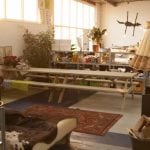Creativity & Sustainability
Last Friday we gave a lecture on the topic of business creativity and sustainability. This article is an excerpt from our talk.
Every organisation needs creativity, and we are all obliged to find more sustainable ways of working. At HatRabbits we are convinced that anyone is capable of generating creative ideas. We also believe that every organisation can innovate in a sustainable way, taking into account the famous trinity; people, planet and profit.
In this article, I’d like to share with you three simple strategies that I hope will inspire you to search for sustainable ideas to innovate your business.
1. Make new combinations
Creativity is all about combining existing elements to create something new. Strange combinations have always been the foundation of great inventions and innovations.
Rubble + Lego
In many third world countries rubble (caused by war and natural disasters) is an important cause of several public health issues. While in the Netherlands we reuse 100% of our rubble, in developing countries rubble is still seen as useless waste. Often it is dumped in rivers and in nature.
Gerard Steijn, a Dutch social entrepreneur combined the problem of rubble with Lego bricks and created what he calls ‘The Mobile Factory’. The factory, the size of a shipping container, can be placed in any area destroyed by war or earthquakes. The factory takes in rubble and turns it into liquid concrete. It then transforms it back again, into stackable Lego brick shaped concrete blocks.
One “mobile factory” can produce up to 10 to 20 buildings a day. The houses built from these bricks are cheaper than normal buildings (they don’t need new building material), are earthquake-proof, and are much more comfortable than the tents most inhabitants are currently living in.
By combining two seemingly distinct worlds, toys and construction work, a beautifully efficient new way of building (and getting rid of rubble) arose.
2. Challenge assumptions
In every business, you can find many written and unwritten rules. These rules are often useful and necessary. However, they can also almost always be bent or broken. Creativity is all about daring to challenge the obvious. If you want to change things, you first have to change the way you look at them.
Inglorious Fruits and Vegetables
Each year we throw away a lot of good food. Take fruit and vegetables for example. A lot of it is rejected simply because it looks weird or unattractive. Supermarkets don’t want to buy unappealing fruit and vegetables. They assume that people don’t want to buy straight bananas and crooked cucumbers. Intermarché, a large supermarket chain in France, challenged this assumption successfully and showed that people do buy the ‘inglorious fruits and vegetables’ if you offer them the opportunity.
By challenging a common assumption Intermarché did not only prevent food waste, it also got loads of great publicity.
3. Copy from nature
In our search for solutions, we sometimes tend to forget that we are surrounded by genius. Many sophisticated and sustainable ideas are already accessible to everyone. The answers we’re looking for can often be found by simply taking a closer look at how ‘Mother Nature’ does things.
Eastgate Centre
In the early ‘90’s, architect Mick Pearce was asked to design a large shopping centre and office block in central Harare, Zimbabwe. He knew that the traditional way of building was everything but ideal. Especially in Africa tall buildings require lots of energy to keep them liveable in terms of temperature.
In his search for a more sustainable approach, Pearce discovered an elegant solution developed by termites. Termites live on fungus, that grows inside their mounds and that has to be kept at an exact temperature to stay alive. Despite the high fluctuations of temperatures outside termite mounds (extremely hot during the day and freezing cold during the night), the temperature inside the mound is always the same, because of a self-regulating ventilation system.
Mick Pearce studied the mounds and used it as a source of inspiration. The new design was so successful that the Eastgate Centre requires a whopping 90% less energy than traditional buildings.
Nature has been innovating for about 3.8 billion years, so if you’re looking for sustainable solutions you should probably look at plants and animals first.
In short
The next time you’re looking for a clever new idea, remember three things:
1. make new combinations (especially when these combinations seem illogical)
2. challenge your assumptions (for nearly every rule can be bent or broken)
3. ask yourself if possibly Mother Nature has already solved your problem.





